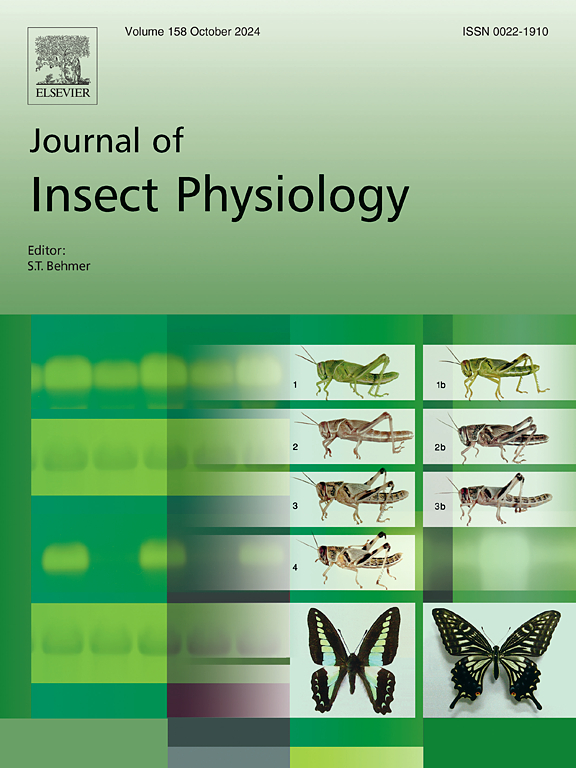昆虫冷冻保护剂功能研究中的缺陷:以驼背果蝇肌醇为例
IF 2.3
2区 农林科学
Q1 ENTOMOLOGY
引用次数: 0
摘要
一种潜在的低温保护物质的积累与抗寒性的增加之间的相关性已经在许多冷适应昆虫中得到了证明。然而,文献对积累物质的冷冻保护功能提供了很少的直接证据。在这里,我们试图获得肌醇在成年北方果蝇(Drosophila lummei)中非累加冷冻保护功能的直接证据。滞育蝇在数周模拟冬季来临的逐渐冷驯化过程中积累了高达500 mmol·kg−1新鲜质量的肌醇浓度。与此同时,他们的抗寒性,通过五个不同的指标来衡量,大大提高了。我们发现肌醇的主要来源是糖原分解为葡萄糖单位,随后通过Inos基因编码的肌醇磷酸合酶的活性进行转化。在冷驯化过程中,Inos的相对表达量增加了86倍。我们成功地增加了预适应果蝇体内肌醇的水平,达到了与冷适应的水平相当的水平。然而,该研究表明,两种外源性肌醇输送方法(微量注射到血淋巴和饲喂富集饲料)都不能实现肌醇的适当组织定位,肌醇主要在胸飞行肌和中枢神经系统中自然积累。与此同时,肌醇浓度的人为增加对五项测得的抗寒性指标都没有影响。最后,我们讨论了昆虫冷冻保护剂功能研究的各种缺陷,并确定了克服这些缺陷的方法。本文章由计算机程序翻译,如有差异,请以英文原文为准。

Pitfalls in insect cryoprotectant functional studies: A case study of myo-inositol in Drosopila lummei
The correlation between the accumulation of a potentially cryoprotective substance and the increase in cold hardiness has been documented in many cold-acclimated insects. Nevertheless, the literature offers scant direct evidence for the cryoprotective function of the accumulated substances. Here, we sought to obtain direct evidence of non-colligative cryoprotective function of myo-inositol in adults of boreal fly, Drosophila lummei. The diapause flies accumulated myo-inositol in concentration of up to 500 mmol·kg−1 fresh mass during several weeks of gradual cold acclimation simulating winter onset. Concurrently, their cold hardiness, measured by five different metrics, substantially increased. We found that the primary source of myo-inositol is glycogen breakdown to glucose units, followed by their subsequent conversion through the activity of myo-inositol phosphate synthase, which is encoded by the Inos gene. The relative expression of Inos increased 86-fold during cold acclimation. We successfully augmented the levels of myo-inositol in the bodies of pre-acclimated flies, achieving levels comparable to those attained through cold acclimation. However, the study demonstrated that both methods of exogenous myo-inositol delivery (microinjection into the hemolymph and feeding enriched diets) were unsuccessful in achieving proper tissue localization of myo-inositol, which naturally accumulates primarily in the thoracic flight muscles and CNS. At the same time, the artificial increase in myo-inositol concentration did not affect any of the five measured cold hardiness metrics. We conclude by discussing various pitfalls of functional studies of insect cryoprotectants and identify ways to overcome them.
求助全文
通过发布文献求助,成功后即可免费获取论文全文。
去求助
来源期刊

Journal of insect physiology
生物-昆虫学
CiteScore
4.50
自引率
4.50%
发文量
77
审稿时长
57 days
期刊介绍:
All aspects of insect physiology are published in this journal which will also accept papers on the physiology of other arthropods, if the referees consider the work to be of general interest. The coverage includes endocrinology (in relation to moulting, reproduction and metabolism), pheromones, neurobiology (cellular, integrative and developmental), physiological pharmacology, nutrition (food selection, digestion and absorption), homeostasis, excretion, reproduction and behaviour. Papers covering functional genomics and molecular approaches to physiological problems will also be included. Communications on structure and applied entomology can be published if the subject matter has an explicit bearing on the physiology of arthropods. Review articles and novel method papers are also welcomed.
 求助内容:
求助内容: 应助结果提醒方式:
应助结果提醒方式:


